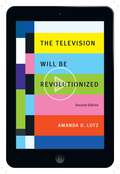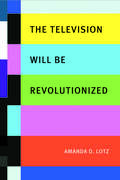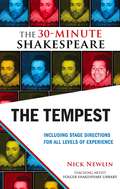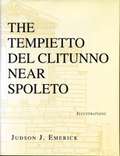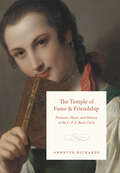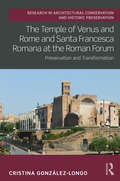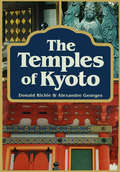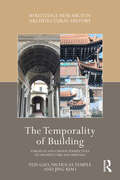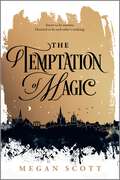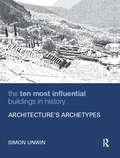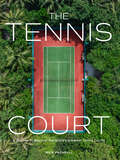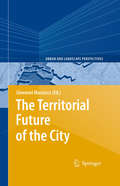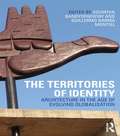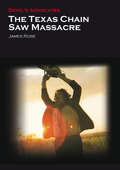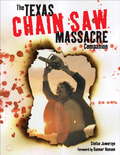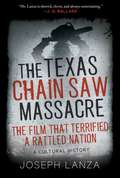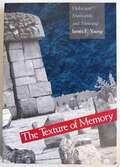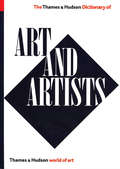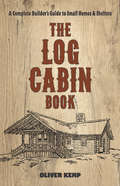- Table View
- List View
The Television Will Be Revolutionized, Second Edition
by Amanda D Lotz&“Incredibly prescient . . . the revised edition updates its account to reflect an age when Hulu, Netflix, and Amazon are now competing for Emmy and Peabody Awards.&” —Henry Jenkins, coauthor of Spreadable Media: Creating Meaning and Value in a Networked Culture Many proclaimed the &“end of television&” in the early years of the twenty-first century, as capabilities and features of the boxes that occupied a central space in American living rooms for the preceding fifty years were radically remade. In this revised second edition of her definitive book, Amanda D. Lotz proves that rumors of the death of television were greatly exaggerated and explores how new distribution and viewing technologies have resurrected the medium. Shifts in the basic practices of making and distributing television have not been hastening its demise but redefining what we can do with it, what we expect from it, how we use it—in short, revolutionizing it. Television, as both a technology and a tool for cultural storytelling, remains as important today as ever, but it has changed in fundamental ways. The Television Will Be Revolutionized provides a sophisticated history of the present, examining television in what Lotz terms the &“post-network&” era while providing frameworks for understanding the continued change in the medium. The second edition addresses adjustments throughout the industry wrought by broadband-delivered television such as Netflix, YouTube, and cross-platform initiatives like TV Everywhere, as well as how technologies such as tablets and smartphones have changed how and where we view. Lotz begins to deconstruct the future of different kinds of television—exploring how &“prized content,&” live televised sports, and linear viewing may all be &“television,&” but very different types of television for both viewers and producers. Through interviews with those working in the industry, surveys of trade publications, and consideration of an extensive array of popular shows, Lotz takes us behind the screen to explore what is changing, why it is changing, and why the changes matter. &“[A] thorough and engaging analysis.&” —Velvet Light Trap &“Thick with trade facts and figures.&” —Popular Communication
The Television Will be Revolutionized
by Amanda D. LotzChoice Outstanding Academic Title for 2008After occupying a central space in American living rooms for the past fifty years, is television, as we've known it, dead? The capabilities and features of that simple box have been so radically redefined that it's now nearly unrecognizable. Today, viewers with digital video recorders such as TiVo may elect to circumvent scheduling constraints and commercials. Owners of iPods and other portable viewing devices are able to download the latest episodes of their favorite shows and watch them whenever and wherever they want. Still others rent television shows on DVD, or download them through legal and illegal sources online. But these changes have not been hastening the demise of the medium. They are revolutionizing it. The Television Will Be Revolutionized examines television at the turn of the twenty-first century —:what Amanda D. Lotz terms the "post-network" era. Television, both as a technology and a tool for cultural storytelling, remains as important today as ever, but it has changed in fundamental ways as the result of technological innovations, proliferating cable channels targeting ever more specific niche audiences, and evolving forms of advertising such as product placement and branded entertainment. Many of the conventional practices and even the industry's basic business model are proving unworkable in this new context, resulting in a crisis in norms and practices.Through interviews with those working in the industry, attendance of various industry summits and meetings, surveys of trade publications, and consideration of an extensive array of popular television shows, Lotz takes us behind the screen to explore what is changing, why it's changing, and why these changes matter.
The Tempest
by Nick NewlinThe Tempest: The 30-Minute Shakespeare offers eight scenes from this rich comedy. Beginning with the magical storm and shipwreck, this adaptation includes the uproarious discovery of the monster Caliban and his plot to kill Prospero. Included are the heartfelt marriage vows between Ferdinand and Miranda, the disguised antics of fairy Ariel, and Prospero's poetic abjuration of his rough magic. The edition includes a preface by Nick Newlin containing helpful advice on how to put on a Shakespeare performance in a high school class with novice actors as well as an appendix with suggestions for the specific play and recommendations for further resources.
The Tempietto del Clitunno near Spoleto
by Judson EmerickThis is the first full-length study of the enigmatic Early Medieval chapel near the river Clitunno in central Umbria. Judson Emerick makes the Tempietto del Clitunno, a celebrated art-historical test case, the focus of a study that penetrates to the deep structure of the discipline.For centuries scholars have puzzled over the chapel's lavish Corinthian column screens, the crosses surrounded by Neo-Attic vine scrolls in its pedimental reliefs, and the Christian Latin inscriptions in huge Neo-Augustan block capitals from its friezes. The sixteenth-century humanists who named the building the "Tempietto del Clitunno" treated it as an ancient Roman temple that the Christians later converted. But modern art historians, learning that the Tempietto had been built from the ground up as a chapel, declared it an anomaly, the product of a most startling and unexpected Early Christian and medieval classical revival.Emerick intervenes by critiquing the notion of classical revival in medieval architecture. Impatient with the old Enlightenment historical plot that makes the Tempietto into a dark-age prodigy, Emerick boldly redescribes the architectural record to take away the Tempietto's strangeness. He shows conclusively that the chapel's orders, pedimental reliefs, and inscriptions conform to ancient Roman Imperial Corinthian standards, but then goes on to show that just this Corinthian decorative system was frequent, even normal in festive, public, Christian cult rooms from Constantine's day down through the twelfth century.History of style as an end in itself yields here to style treated as political phenomenon. Emerick turns to the frescoes on the Tempietto's rear apse wall for clues to the builders' political goals. He explains how grandees from the medieval Lombardo-Frankish Duchy of Spoleto, full participants in a Christian theocratic state, set up an array of Mediterranean icons inside the Tempietto to enhance their social and political control. The chapel's Corinthian decorative system, he concludes, must be integral to this political program.
The Tempietto del Clitunno near Spoleto
by Judson EmerickThis is the first full-length study of the enigmatic Early Medieval chapel near the river Clitunno in central Umbria. Judson Emerick makes the Tempietto del Clitunno, a celebrated art-historical test case, the focus of a study that penetrates to the deep structure of the discipline.For centuries scholars have puzzled over the chapel's lavish Corinthian column screens, the crosses surrounded by Neo-Attic vine scrolls in its pedimental reliefs, and the Christian Latin inscriptions in huge Neo-Augustan block capitals from its friezes. The sixteenth-century humanists who named the building the "Tempietto del Clitunno" treated it as an ancient Roman temple that the Christians later converted. But modern art historians, learning that the Tempietto had been built from the ground up as a chapel, declared it an anomaly, the product of a most startling and unexpected Early Christian and medieval classical revival.Emerick intervenes by critiquing the notion of classical revival in medieval architecture. Impatient with the old Enlightenment historical plot that makes the Tempietto into a dark-age prodigy, Emerick boldly redescribes the architectural record to take away the Tempietto's strangeness. He shows conclusively that the chapel's orders, pedimental reliefs, and inscriptions conform to ancient Roman Imperial Corinthian standards, but then goes on to show that just this Corinthian decorative system was frequent, even normal in festive, public, Christian cult rooms from Constantine's day down through the twelfth century.History of style as an end in itself yields here to style treated as political phenomenon. Emerick turns to the frescoes on the Tempietto's rear apse wall for clues to the builders' political goals. He explains how grandees from the medieval Lombardo-Frankish Duchy of Spoleto, full participants in a Christian theocratic state, set up an array of Mediterranean icons inside the Tempietto to enhance their social and political control. The chapel's Corinthian decorative system, he concludes, must be integral to this political program.
The Temple of Fame and Friendship: Portraits, Music, and History in the C. P. E. Bach Circle
by Annette RichardsThis book examines the renowned portrait collection assembled by C. P. E. Bach, J. S. Bach’s second son. One of the most celebrated German composers of the eighteenth century, C. P. E. Bach spent decades assembling an extensive portrait collection of some four hundred music-related items—from oil paintings to engraved prints. The collection was dispersed after Bach’s death in 1788, but with Annette Richards’s painstaking reconstruction, the portraits once again present a vivid panorama of music history and culture, reanimating the sensibility and humor of Bach’s time. Far more than a mere multitude of faces, Richards argues, the collection was a major part of the composer’s work that sought to establish music as an object of aesthetic, philosophical, and historical study. The Temple of Fame and Friendship brings C. P. E. Bach’s collection to life, giving readers a sense of what it was like for visitors to tour the portrait gallery and experience music in rooms thick with the faces of friends, colleagues, and forebears. She uses the collection to analyze the “portraitive” aspect of Bach’s music, engaging with the influential theories of Swiss physiognomist Johann Caspar Lavater. She also explores the collection as a mode of cultivating and preserving friendship, connecting this to the culture of remembrance that resonates in Bach’s domestic music. Richards shows how the new music historiography of the late eighteenth century, rich in anecdote, memoir, and verbal portrait, was deeply indebted to portrait collecting and its negotiation between presence and detachment, fact and feeling.
The Temple of Fame and Friendship: Portraits, Music, and History in the C. P. E. Bach Circle
by Annette RichardsThis book examines the renowned portrait collection assembled by C. P. E. Bach, J. S. Bach’s second son. One of the most celebrated German composers of the eighteenth century, C. P. E. Bach spent decades assembling an extensive portrait collection of some four hundred music-related items—from oil paintings to engraved prints. The collection was dispersed after Bach’s death in 1788, but with Annette Richards’s painstaking reconstruction, the portraits once again present a vivid panorama of music history and culture, reanimating the sensibility and humor of Bach’s time. Far more than a mere multitude of faces, Richards argues, the collection was a major part of the composer’s work that sought to establish music as an object of aesthetic, philosophical, and historical study. The Temple of Fame and Friendship brings C. P. E. Bach’s collection to life, giving readers a sense of what it was like for visitors to tour the portrait gallery and experience music in rooms thick with the faces of friends, colleagues, and forebears. She uses the collection to analyze the “portraitive” aspect of Bach’s music, engaging with the influential theories of Swiss physiognomist Johann Caspar Lavater. She also explores the collection as a mode of cultivating and preserving friendship, connecting this to the culture of remembrance that resonates in Bach’s domestic music. Richards shows how the new music historiography of the late eighteenth century, rich in anecdote, memoir, and verbal portrait, was deeply indebted to portrait collecting and its negotiation between presence and detachment, fact and feeling.
The Temple of Venus and Rome and Santa Francesca Romana at the Roman Forum: Preservation and Transformation (Routledge Research in Architectural Conservation and Historic Preservation)
by Cristina González-LongoThis book examines the influence of architectural design in the conservation of historic buildings by discussing in detail an important building complex in Rome: the Temple of Venus and Rome, the monastery of Santa Maria Nova and the church of Santa Francesca Romana. As the most complete site in the Roman Forum that has reached our times with a rich architectural stratification almost intact, it is a clear product of continuous preservation and transformation and it has not been studied in its complexity until now. The Temple of Venus and Rome and Santa Francesca Romana at the Roman Forum unravels the original designs and the subsequent interventions, including Giacomo Boni’s pioneering conservation of the monastery, carried out while excavating the Roman Forum in the early twentieth century. The projects are discussed in context to show their significance and the relationships between architects and patrons. Through its interdisciplinary focus on architectural design, conservation, archaeology, history and construction, this study is an ideal example for scholars, students and architects of how to carry out research in architectural conservation.
The Temples of Kyoto
by Donald Richie Alexandre GeorgesThe Temples of Kyoto takes you on a journey through these environs and presents twenty-one of these marvelous structures that are unique creations which, while quintessentially Japanese, somehow speak a universal languagereadily appreciated by people the world over. Donald Richie, called by Time magazine, "the dean of art critics in Japan," turns his attention to these twenty-one temples with scholarship and an eye for the dramatic. Drawingoff such classic sources as The Tale of Genji and Essays in Idleness, he takes the reader on a tour through the ages, first with a comprehensive history of Japanese Buddhism, and then by highlighting key events in the development of these "celestial-seeming cities." From the Tendai warrior-priests of Enryaku-ji to the floating vision of paradise at Byodo-in, to the magical gardens of Tofuku-ji, the past springs into the present and the temples truly take on a life of their own in a thrilling narrative that weaves fact and legend into a guide as entertaining as it is informative. Brilliant photographs of the temples, taken by the award-winning photographer Alexandre Georges, complement the text and provide a visual overview of the subject matter. His keen eye captures on film the elements that make each temple noteworthy, including their interiors, and objets d'art, in a fresh and thought provoking manner. The result is this book: a testament and meditation on the power and elegance of these world-renowned structures that are both places of worship and examples of the finest art Japan has ever produced.
The Temporality of Building: European and Chinese Perspectives on Architecture and Heritage (Routledge Research in Architectural History)
by Yun Gao Nicholas Temple Jing XiaoThis book examines the role that time plays in the life of buildings, adopting a comparative study of this influence between European and Chinese traditions. Whilst issues of time in architecture have attracted increasing interest by academics in the West, challenging the dominant modernist precepts of space, there is little understanding of the subject in China and how these compare to historical and contemporary perspectives in Europe. A guiding premise of the investigation is that notions of building time require insight into how cultural habits commingle with natural rhythms, or what David Leatherbarrow calls “concurrency”.Rather than examining specific buildings, the first three chapters apply three key themes (language, ritual and heritage) as cultural lenses to reveal differences and similarities between the two traditions. Through these lenses, buildings, interiors and their exterior spaces (churches/cathedrals, temples, palaces, gardens and courtyard houses) are explored to demonstrate how building time involves particular situations/settings and their correlating relationships to past traditions. In the final chapter we consider notions of time in the context of contemporary buildings in Europe and China, drawing on the earlier historical investigations and addressing globalising influences.This book would be of interest to architects, architectural theorists, historians, philosophers, sociologists and anthropologists.
The Temptation of Despair
by Werner SollorsIn Germany the end of World War II calls forth images of obliterated cities, hungry refugees, and ghostly monuments to Nazi crimes. Drawing on diaries, photographs, essays, reports, fiction and film, Werner Sollors makes visceral the sorrow and anger, guilt and pride, despondency and resilience of a defeated people--and the paradoxes of occupation.
The Temptation of Magic
by Megan ScottAn International Bestseller!Perfect for fans of A Discovery of Witches and Serpent & Dove, this mesmerizing dark academia romantasy debut delves into a dangerous supernatural society hidden within our own—where forbidden love and immortal hunters collide, and a dark truth may unravel the entire world.Nicole Palmer and her family have been in hiding for years from the Wake—a shadowy organization that governs all supernatural creatures. If the Wake discovers that Nicole is an Empyreal—a rare kind of creature that can shapeshift into any creature&’s natural predator—they&’ll force her to join them or kill her for resisting. Like they did her mother. Nicole is close to uncovering a secret message hidden in a supernatural art collection—a message from her mother about how to destroy the Wake for good. But when the collector is murdered and a key painting stolen, the Wake sends their best Empyreal assassin to track down the dangerous creature on the loose. Kyan McCarter is handsome, perceptive, and the last person Nicole wants to work with to find the stolen painting. Their search sparks a powerful connection between them, but if Kyan finds out that Nicole is a rogue Empyreal, he&’ll have no choice but to hunt her next. After all, no one disobeys the Wake and survives.
The Ten Most Influential Buildings in History: Architecture’s Archetypes
by Simon UnwinEven the most inventive and revolutionary architects of today owe debts to the past, often to the distant past when architecture really was being invented for the first time. Architects depend on their own imaginations for personal insights and originality but their ideas may be stimulated (consciously or subliminally) by particularly powerful buildings from history. The Ten Most Influential Buildings in History: Architecture's Archetypes identifies ten architectural archetypes that have been sources of inspiration for architects through the centuries. Each archetype is analysed through distinctive examples, following the methodology established by the author in his previous books. The variety of 'lines of enquiry' each archetype has provoked in latter-day architects are then explored by analysing their work to reveal ideas inspired by those earlier buildings. Archetypes have a timeless relevance. In adopting this approach, The Ten Most Influential Buildings in History is as pertinent to contemporary practice as it is to understanding buildings from antiquity, and offers insights into the bridges of influence that can operate between the two.
The Tennis Court: A Journey to Discover the World's Greatest Tennis Courts
by Nick PachelliA fresh approach to a beloved sport, The Tennis Court is a photographic journey of the 200 most breathtaking tennis courts around the world. &“Nick Pachelli takes us on court in every corner of the world with a sharp eye for what makes our game and the people who champion it so special.&” —Billie Jean King, sports icon and equality advocate Every one of the world&’s half a million tennis courts is, at its most basic, an identical blank canvas: a 78-foot by 36-foot rectangle, divided by a 3-foot-high net in its center, and marked with eleven straight lines. But add in the elements of surface, space, wind, acoustics, crowds, shadows, humidity, and even air density, and every tennis court is unique—a work of art. And some are masterpieces. Nick Pachelli curates and profiles 200 of the world&’s most beautiful, iconic, significant, alluring, and idiosyncratic tennis courts from across the globe, each breathtakingly photographed. He explores the heavyweights, including Wimbledon&’s All England Lawn Tennis Club, which employs a hawk to keep stray birds from soiling the meticulous lawns. Arthur Ashe, the Grandstand, and Court 17 in Flushing, Queens, where hundreds of thousands of tennis fans gather every summer for the US Open. And there&’s Court Philippe-Chatrier at Roland-Garros, whose clay seems to take on a different shade—burnt orange, burnt red, burgundy, umber—every time you see it. We visit far-flung treasures, such as Waiheke Tennis Club in New Zealand, where you&’ll need to take a plane, then a ferry, then a car or bus, and then walk before arriving there. Indoor marvels, including the Tennis Club de Belgique, which evokes the hushed, reverent feeling of a theater, with skylights illuminating the court and leaving the spectators in the shadows. Hidden jewels, such as the tiny Tennis Club San Stin in Venice, a secret, single outdoor clay court tucked away behind a villa and a 15-foot wall shrouded with vines. There are urban courts, including the Knickerbocker Field Club, deep in the heart of Flatbush, Brooklyn. Academies, like Rafael Nadal&’s tennis temple in Mallorca, Spain. And the extreme: a single court completely isolated in the wilds of Scotland; a court in northern Spain revealed when the tide goes out, the sand hardens, and the metallic plates that serve as lines reemerge; and a court in Kenya made out of termite mounds. Throughout, Pachelli not only conducts a masterful, once-in-a-lifetime tour of the world&’s best courts, but in his writing does something equally immersive: He captures the real passion—some might say obsession—that tennis inspires. Because it&’s on the court, no matter how grandiose or mundane, whether in an exotic locale or around the corner, where tennis players truly see themselves. Where we come face-to-face with our temperament, our drive, our frustration, our bliss, our longing.
The Territorial Future of the City
by Giovanni MacioccoThe volume brings together contributions by leading scholars and young academics with experience in the urban potential of the territory in situations not necessarily linked to the dense metropolis, its compact form or to city sprawl. What brings these scholars together is their common reflection on this central theme, though from varied disciplinary and experimental backgrounds. They offer new forms of representing social and spatial processes of the contemporary society.
The Territories of Identity: Architecture in the Age of Evolving Globalization
by Soumyen Bandyopadhyay Guillermo Garma MontielThe expedited globalised process of exchange and new forms of cultural production have transformed old established notions of identity, calling into question their conceptual foundations. This book explores the spatial and representational dimension of this phenomenon, by addressing how the reshaping of the key themes of place, architecture and memory are altering the nature, as well as, our understanding of identity. Cutting across boundaries, the book drives discussion of identity beyond the well-worn concern for its loss within a globalised context, and importantly provides links between identity, place, memory and representation in architecture. Examining a range of case studies from Australia, Germany, India, Japan, Mexico, Poland, Puerto Rico, Turkey and Singapore, as well as with contributions cutting across geographical and temporal boundaries, this volume addresses such issues as architecture technology, place and memory – critical issues in the monitoring and mapping of identity shift within a rapidly globalising context. With contributions from renowned authors in the field including Nicholas Temple, Patsy Hely, Robert Brown, Liane Lefaivre, John Hendrix, Ana Souto, Fiona MacLaren, Stephen Walker, Nezar AlSayyad, Andrzej Piotrowski, Catherine Ettinger, Luz Marie Rodríguez, and Raymond Quek this book presents fresh insights and diverse perspectives on the evolving question of identity and globalisation.
The Texas Chain Saw Massacre
by James RoseAs well as providing a summary of the making of the film, James Rose discusses the extraordinary censorship history of the film in the UK (essentially banned for two decades) and provides a detailed textual analysis of the film
The Texas Chain Saw Massacre
by James RoseNo-one who has ever seen the original The Texas Chain Saw Massacre (1974) is ever likely to forget the experience. An intense fever dream (or nightmare), it is remarkable for its sense of sustained threat and depiction of an insane but nonetheless (dys)functional family on the furthest reaches of society who have regressed to cannibalism in the face of economic hardship. As well as providing a summary of the making of the film, James Rose discusses the extraordinary censorship history of the film in the UK (essentially banned for two decades) and provides a detailed textual analysis of the film with particular reference to the concept of 'the Uncanny'. He also situates the film in the context of horror film criticism (the 'Final Girl' character) and discusses its influence and subsequent sequels and remakes.
The Texas Chain Saw Massacre
by Stefan JaworzynIn 1974, a low-budget, no-star horror movie was unleashed on the world, causing panic among the censors and provoking glee from its intended audience. The Texas Chain Saw Massacre is still as powerful today as when it was first seen almost thirty years ago, and will return to the screens in a high profile remake this Halloween. Now, in this long-awaited companion to Tobe Hooper's groundbreaking film, Stefan Jaworzyn gives us the inside story of one of the most successful, controversial and influential horror films ever made, as well as in-depth coverage of the three sequels, various documentaries and other movies also based on the life of serial killer Ed Gein. Packed with exclusive interviews, rare and unseen pictures, and with a foreword from the chainsaw-wielding Leatherface himself, Gunnar Hansen!
The Texas Chain Saw Massacre (Devil's Advocates Ser.)
by James RoseNo-one who has ever seen the original The Texas Chain Saw Massacre (1974) is ever likely to forget the experience. An intense fever dream (or nightmare), it is remarkable for its sense of sustained threat and depiction of an insane but nonetheless (dys)functional family on the furthest reaches of society who have regressed to cannibalism in the face of economic hardship. As well as providing a summary of the making of the film, James Rose discusses the extraordinary censorship history of the film in the UK (essentially banned for two decades) and provides a detailed textual analysis of the film with particular reference to the concept of 'the Uncanny’. He also situates the film in the context of horror film criticism (the 'Final Girl’ character) and discusses its influence and subsequent sequels and remakes.
The Texas Chain Saw Massacre: The Film That Terrified a Rattled Nation
by Joseph LanzaWhen Tobe Hooper’s low-budget slasher film, The Texas Chainsaw Massacre, opened in theaters in 1974, it was met in equal measure with disgust and reverence. The film—in which a group of teenagers meet a gruesome end when they stumble upon a ramshackle farmhouse of psychotic killers—was outright banned in several countries and was pulled from many American theaters after complaints of its violence. Despite the mixed reception from critics, it was enormously profitable at the domestic box office and has since secured its place as one of the most influential horror movies ever made. In The Texas Chainsaw Massacre and Its Terrifying Times, cultural critic Joseph Lanza turns his attentions to the production, reception, social climate, and impact of this controversial movie that rattled the American psyche. Joseph Lanza transports the reader back to the tumultuous era of the 1970s defined by political upheaval, cultural disillusionment, and the perceived decay of the nuclear family in the wake of Watergate, the onslaught of serial killers in the US, as well as mounting racial and sexual tensions. The Texas Chainsaw Massacre and Its Terrifying Times sets the themes of the film against the backdrop of the political and social American climate to understand why the brutal slasher flick connected with so many viewers. As much a book about the movie as the moment, Joseph Lanza has created an engaging and nuanced work that grapples with the complications of the American experience.
The Texture of Memory: Holocaust Memorials and Meaning
by James E. YoungIn Dachau, Auschwitz, Yad Vashem, and thousands of other locations throughout the world, memorials to the Holocaust are erected to commemorate its victims and its significance. This fascinating work by James E. Young examines Holocaust monuments and museums in Europe, Israel, and America, exploring how every nation remembers the Holocaust according to its own traditions, ideals, and experiences, and how these memorials reflect their place in contemporary aesthetic and architectural discourse. The result is a groundbreaking study of Holocaust memory, public art, and their fusion in contemporary life. <p><p>Among the issues Young discusses are: how memorials suppress as much as they commemorate; how museums tell as much about their makers as about events; the differences between memorials conceived by victims and by victimizers; and the political uses and abuses of officially cast memory. Young describes, for example, Germany's "counter monuments," one of which was designed to disappear over time, and the Polish memorials that commemorate the whole of Polish destruction through the figure of its murdered Jewish part. He compares European museums and monuments that focus primarily on the internment and killing process with Israeli memorials that include portrayals of Jewish life before and after the destruction. In his concluding chapters, he finds that American Holocaust memorials are guided no less by distinctly American ideals, such as liberty and pluralism. <p><p>Interweaving graceful prose and arresting photographs, the book is eloquent testimony to the way varied cultures and nations commemorate an era that breeds guilt, shame, pain, and amnesia, but rarely pride. By reinvigorating these memorials with the stories of their origins, Young highlights the ever-changing life of memory over its seemingly frozen face in the landscape.
The Thames and Hudson Dictionary of Art and Artists (Expanded, Updated) (World of Art)
by Herbert Read"Excellent, concise . . . highly recommended." --Choice This extensively illustrated dictionary provides information on over 2,500 artists, paintings, sculptures, drawings, prints, schools and movements throughout the world, including entries on contemporary art and artists, techniques, materials, terms, and writers who have influenced artists.
The Thames and Hudson Encyclopedia of the Italian Renaissance
by J. R. HaleWithin the vast literature of the Renaissance, this is the one indispensable book: for the student who wants a guide to the complicated maze of Italian Renaissance political history.
The The Log Cabin Book: A Complete Builder's Guide to Small Homes and Shelters
by Oliver KempThis vintage guide from over a century ago offers timeless, practical advice on building log cabins. Plans and directions for simple structures are easy enough for amateurs to follow; time and inclination are the only necessary elements. Each of the designs has been tested and allows numberless alterations to suit the builder's tastes and requirements. Instructions range from selecting a site and safe, efficient methods of cutting down trees for building materials to building an ice house and boathouse to furnishing and decorating interiors. Photographs and drawings provide clear images for a variety of wilderness homes, including floor plans for The Block House, Wildwood, Crow's Nest, Idlewild, and other rustic retreats. Rich in nostalgic charm as well as useful applications, this manual offers priceless guidance to handymen, woodworkers, and hunters as well as those interested in small houses, construction, and home history and seekers of off-the-grid, environmentally friendly living.
